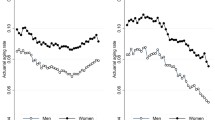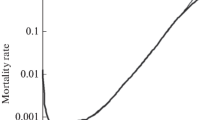Abstract
It was found that changes in the mortality rate with age, minus the background constant of the Gompertz–Makeham formula, the increment in the mortality rate, as well as the exponential coefficient of this formula, reflect the actual rate of human aging. Using age-related mortality data for 40 countries, it is shown that the rate of aging does not change significantly over history and is almost the same for different countries from the mid-18th to the mid-20th century. It was noted that its linear growth persists (on a logarithmic scale), starting from the end of the period of development and growth of the body until the age of centenarians, when the speed of aging is reduced (due to the inherited longevity of the population). However, since the mid-20th century for the first time in history, slowing of the rate of aging in all parameters, including maximum life span, which is apparently associated with pronounced success in the economy and in health and social care, has been noted.



Similar content being viewed by others
REFERENCES
Barbi, E., Lagona, F., Marsili, M., Vaupel, J.W., and Wachter, K.W., The plateau of human mortality: demography of longevity pioneers, Science, 2018, vol. 360, no. 6396, pp. 1459–1461.
De Beer, J., Bardoutsos, A., and Janssen, F., Maximum human lifespan may increase to 125 years, Nature, 2017, vol. 546, no. 7670, pp. E16–E17.
Dato, S., Rose, G., Crocco, P., Monti, D., Garagnani, P., Franceschi, C., and Passarino, G., The genetics of human longevity: an intricacy of genes, environment, culture and microbiome, Mech. Ageing Dev., 2017, vol. 165, pt B, pp. 147–155.
Dong, X., Milholland, B., and Vijg, J., Evidence for a limit to human lifespan, Nature, 2016, vol. 538, no. 7624, pp. 257–259.
Dontsov, V.I., Aging of populations, Certificate of State Registration of a Computer Program no. 2019617794 from June 20, 2019a.
Dontsov, V.I., Changes in mortality and aging rate in the second half of the 20th century in Russia, Zdravookhr. Ross. Fed., 2019b, vol. 63, no. 1, pp. 42–47. 22
Finch, C.E., Evolution of the human lifespan and diseases of aging: roles of infection, inflammation, and nutrition, Proc. Natl. Acad. Sci. U. S. A., 2010, vol. 107, no. 1, pp. 1718–1724.
Gavrilov, L.A. and Gavrilova, N.S., The Biology of Life Span: A Quantitative Approach, New York: Harwood Acad. Publ., 1991.
Gompertz, B., On the nature of the function expressive of the law of human mortality, and on the mode of determining the value of life contingencies, Philos. Trans. R. Soc., A, 1825, vol. 115, pp. 513–585.
Hayflick, L., Entropy explains aging, genetic determinism explains longevity, and undefined terminology explains misunderstanding both, PLoS Genet., 2007, vol. 3, no. 12. e220.
Krut’ko, V.N., Dontsov, V.I., Khalyavkin, A.V., and Markova, A.N., Natural aging as a sequential poly-systemic syndrome, Front. Biosci., Landmark Ed., 2018, vol. 23, pp. 909–920.
Lenart, A. and Vaupel, J.W., Questionable evidence for a limit to human lifespan, Nature, 2017, no. 546, pp. E13–E14.
Ribeiro, A.I., Krainski, E.T., Carvalho, M.S., and De Fátima de Pina, M., The influence of socioeconomic deprivation, access to healthcare and physical environment on old-age survival in Portugal, Geospat. Health, 2017, vol. 12, no. 2, p. 581.
Author information
Authors and Affiliations
Corresponding author
Ethics declarations
The author declares that he has no conflict of interest. This article does not contain any studies involving animals or human participants performed by the author.
Rights and permissions
About this article
Cite this article
Dontsov, V.I. Historical Stability of the Human Aging Rate and Its Decline in Our Time. Biol Bull Russ Acad Sci 48, 103–106 (2021). https://doi.org/10.1134/S1062359021020047
Received:
Revised:
Accepted:
Published:
Issue Date:
DOI: https://doi.org/10.1134/S1062359021020047




